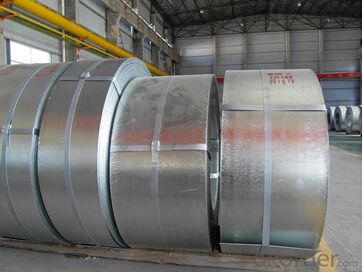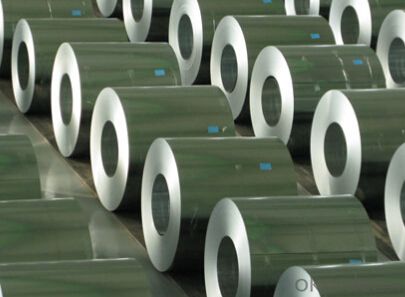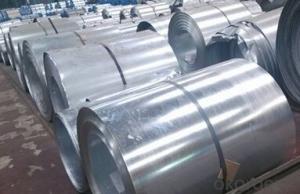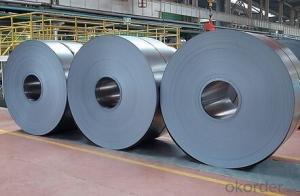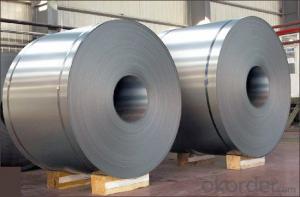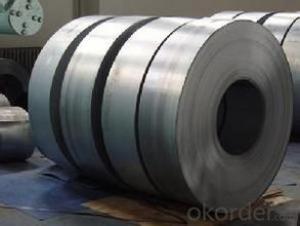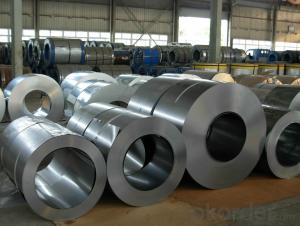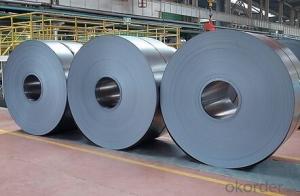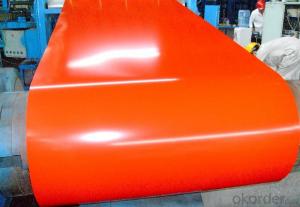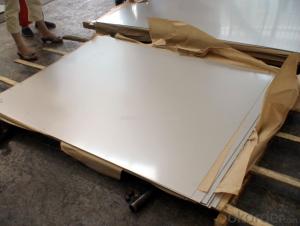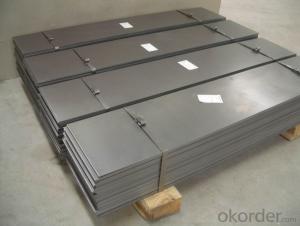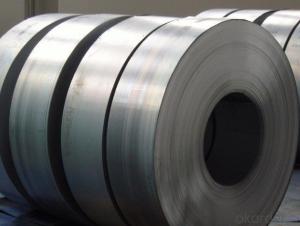Cold Rolled Steel Coil JIS G 3302 Walls Steel Coil ASTM 615-009
- Loading Port:
- Tianjin
- Payment Terms:
- TT OR LC
- Min Order Qty:
- 2222 kg/m²
- Supply Capability:
- 11 kg/m²/month
OKorder Service Pledge
OKorder Financial Service
You Might Also Like
1.Structure of Cold Rolled Steel Description:
The raw material of cold rolled steel coil/sheet is high quality hot rolled product, and after pickling continuous rolling, degreasing, annealing,skin pass,slitting and cut to length line etc. Along with it many kinds of new technology and new process of global cold rolling production have been applied. Therefore the quality of the goods could be guaranteed. The product is widely used in outdoor and interior decoration, furnishing manufacturing, home appliance, automobile etc. it has a lower melting point than steel and good castability properties.[1] Certain compositions of cast iron, while retaining the economies of melting and casting, can be heat treated after casting to make malleable iron or ductile iron objects. Steel is also distinguishable from wrought iron (now largely obsolete), which may contain a small amount of carbon but large amounts of slag.
2.Main Features of the Cold Rolled Steel:
• Excellent process capability
• Smooth and flat surface
• Workability, durability
• Excellent heat resistance performance
• High strength
• Good formability
• Good visual effect
Community portal – Bulletin board, projects, resources and activities covering a wide range of Wikipedia areas.
Help desk – Ask questions about using Wikipedia.
Local embassy – For Wikipedia-related communication in languages other than English.
Reference desk – Serving as virtual librarians, Wikipedia volunteers tackle your questions on a wide range of subjects.
Site news – Announcements, updates, articles and press releases on Wikipedia and the Wikimedia Foundation.
Village pump – For discussions about Wikipedia itself, including areas for technical issues and policies.
3.Cold Rolled Steel Images
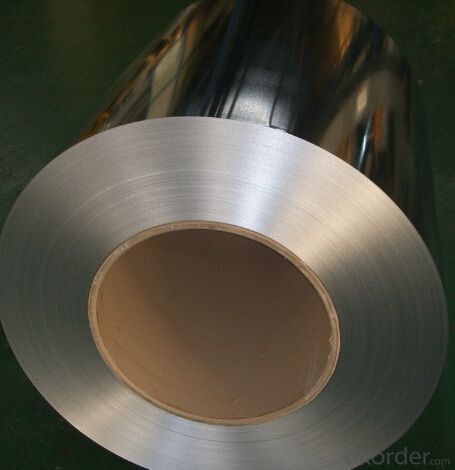
4.Cold Rolled Steel Specification
Standard:AISI,ASTM,DIN,GB,JIS,JIS G3302 ASTM 653M EN10142
Grade: Q195~Q345
Thickness: 0.16mm~1.5mm,0.16-1.5mm
Width: 1250,600-1250mm
Coil weight:3-12 MT
Coil ID:508/610mm
Chemical composition:
C | Si | Mn | Cr | Ni | P | S |
0.150 | 0.476 | 11.231 | 12.50 | 0.900 | 0.039 | 0.010
|
5.FAQ of Cold Rolled Steel
We have organized several common questions for our clients,may help you sincerely:
1.How about your company?
A world class manufacturer & supplier of castings forging in carbon steel and alloy steel,is one of the large-scale professional investment casting production bases in China,consisting of both casting foundry forging and machining factory. Annually more than 8000 tons Precision casting and forging parts are exported to markets in Europe,America and Japan. OEM casting and forging service available according to customer’s requirements.
2.How to guarantee the quality of the products?
We have established the international advanced quality management system,every link from raw material to final product we have strict quality test;We resolutely put an end to unqualified products flowing into the market. At the same time, we will provide necessary follow-up service assurance.
3. How long can we receive the product after purchase?
Usually within thirty working days after receiving buyer’s advance payment or LC. We will arrange the factory manufacturing as soon as possible. The cargo readiness usually takes 15-25 days, but the shipment will depend on the vessel situation.
- Q: Can steel strips be coated with protective coatings?
- Yes, steel strips can be coated with protective coatings. Coating steel strips with protective coatings is a common practice in various industries to enhance their durability, resistance to corrosion, and overall performance. There are several types of protective coatings available for steel, including but not limited to, galvanized coatings, powder coatings, epoxy coatings, and paint coatings. Galvanized coatings, for example, involve applying a layer of zinc to the steel strip through a process known as hot-dip galvanizing. This coating provides excellent corrosion resistance and protects the steel from environmental factors such as moisture and chemicals. Powder coatings are another popular option for protecting steel strips. In this process, a dry powder is applied to the steel strip electrostatically, and then it is cured under heat to create a durable and tough coating. Powder coatings offer excellent adhesion and resistance to abrasion, impact, and chemicals. Epoxy coatings, on the other hand, are commonly used to protect steel strips in harsh environments. These coatings are highly resistant to chemicals, moisture, and extreme temperatures. They provide an additional layer of protection to the steel, preventing corrosion and extending its lifespan. Paint coatings are also widely used to protect steel strips. These coatings can be applied by various methods such as spraying, brushing, or dipping. Paint coatings offer flexibility in terms of color options and can provide a decorative finish in addition to protecting the steel strip from corrosion and other damaging factors. In conclusion, steel strips can indeed be coated with various protective coatings to enhance their performance and longevity. The choice of coating will depend on the specific requirements of the steel strip and the environment it will be exposed to.
- Q: How do steel strips perform in terms of thermal conductivity?
- Steel strips have relatively high thermal conductivity, meaning they are efficient in conducting heat. This property allows them to quickly transfer and distribute thermal energy, making them suitable for various applications that require heat dissipation or heat transfer.
- Q: What is the difference between galvanized and zinc-coated steel strips?
- Galvanized and zinc-coated steel strips have a similar purpose of providing corrosion resistance, but the difference lies in their manufacturing process. Galvanized steel strips are created by immersing the steel in a bath of molten zinc, resulting in a thicker coating that provides better protection. On the other hand, zinc-coated steel strips are produced by electroplating a thin layer of zinc onto the steel surface. This difference in the coating process affects the durability and longevity of the steel strips in different applications.
- Q: What is the difference between annealed and hardened steel strips?
- Annealed and hardened steel strips are two different forms of steel that have undergone different heat treatment processes, resulting in distinct physical properties. Annealed steel strips are heated to a high temperature and then slowly cooled down, a process known as annealing. This process helps to relieve internal stresses and reduce hardness, making the steel more malleable and easier to work with. Annealed steel strips are typically softer, more ductile, and have a lower tensile strength. They are often used in applications where formability and flexibility are important, such as in the manufacturing of automotive components, household appliances, and metal furniture. On the other hand, hardened steel strips have been subjected to a different heat treatment process called hardening. Hardening involves heating the steel to a high temperature and then rapidly cooling it, usually by quenching it in a liquid medium such as oil or water. This rapid cooling process causes the steel to harden and become more rigid, resulting in increased strength, wear resistance, and durability. Hardened steel strips are commonly used in applications where strength and toughness are crucial, such as in the production of cutting tools, springs, and machine parts subjected to high stress or abrasive conditions. In summary, the main difference between annealed and hardened steel strips lies in their physical properties and the heat treatment processes they have undergone. Annealed steel strips are softer and more malleable, while hardened steel strips are harder and more resistant to wear and deformation. The choice between the two depends on the specific application and the desired characteristics of the steel.
- Q: How are steel strips protected against chemicals in industrial environments?
- Steel strips are protected against chemicals in industrial environments through the application of protective coatings or finishes. These coatings are designed to create a barrier between the steel surface and the chemicals, preventing direct contact and potential corrosion. Additionally, certain types of stainless steel or alloys with high resistance to chemical reactions may be used to enhance the overall durability and protection of the steel strips in such environments.
- Q: How are steel strips tested for non-destructive evaluation?
- Steel strips are tested for non-destructive evaluation using various techniques such as ultrasonic testing, magnetic particle testing, eddy current testing, and liquid penetrant testing. These methods allow for the detection of any surface or subsurface defects or discontinuities in the steel strips without causing any damage to the material.
- Q: How do steel strips perform in high-pressure applications?
- Steel strips perform well in high-pressure applications due to their high tensile strength and durability. They can withstand immense pressure without deformation or failure, making them suitable for various industrial uses such as piping systems, hydraulic cylinders, and pressure vessels. Additionally, steel strips can maintain their structural integrity even at elevated temperatures, further enhancing their performance in high-pressure environments.
- Q: Can steel strips be used in the production of power generation equipment?
- Certainly, the utilization of steel strips is applicable in the manufacturing process of power generation equipment. Steel, being an extremely versatile and long-lasting material, finds extensive employment across multiple industries, including power generation. The utilization of steel strips enables the production of diverse components, such as turbine blades, generator frames, and electrical enclosures, to name a few. The exceptional strength and corrosion resistance of steel render it an optimal choice for fulfilling these specific requirements. Moreover, the malleability of steel strips permits effortless shaping and sizing, facilitating customization and optimization of power generation equipment.
- Q: What is the purpose of hardening and tempering steel strips?
- The purpose behind the hardening and tempering of steel strips is to enhance their mechanical properties and enhance their overall performance in various applications. To harden steel strips, they are heated to a specific temperature called the critical temperature and then rapidly cooled by quenching them in oil, water, or air. This rapid cooling process transforms the crystalline structure of the steel, resulting in a material that is harder and stronger. Hardened steel strips are highly resistant to deformation, wear, and abrasion, making them ideal for applications that require high strength and durability, such as cutting tools, springs, and machine components. However, the downside of hardened steel strips is that they can become brittle and prone to cracking. This is where tempering comes into play. Tempering involves reheating the hardened steel strips to a lower temperature and then cooling them slowly. This controlled heating and cooling process allows for the adjustment of the steel's hardness and toughness, finding a balance between strength and its ability to withstand impacts and shocks. By hardening and tempering steel strips, manufacturers can customize the material's properties to meet specific requirements. This allows the steel to possess a combination of hardness, strength, toughness, and flexibility that is suitable for a wide range of applications. Furthermore, hardening and tempering can also enhance the steel's resistance to corrosion and extend its service life.
- Q: How do steel strips respond to different corrosion environments?
- Steel strips can respond differently to various corrosion environments depending on factors such as the type of corrosion, the composition of the steel, and the surrounding conditions. In general, steel strips are susceptible to corrosion, especially when exposed to moisture, oxygen, and aggressive chemicals. However, the response of steel strips to different corrosion environments can vary. In a dry environment with low humidity, steel strips are less likely to corrode significantly. They may develop a thin layer of surface rust, known as cosmetic or superficial corrosion, which does not affect the structural integrity of the steel. This can be easily removed through cleaning or light abrasive methods. In a humid environment, steel strips are more prone to corrosion. The presence of moisture in the air can lead to the formation of rust on the surface of the steel. This type of corrosion can progress over time, causing the steel strips to deteriorate, weaken, and eventually fail if not properly addressed. In marine or saltwater environments, steel strips are highly susceptible to corrosion due to the presence of chloride ions. Chloride ions can penetrate the protective oxide layer on the steel's surface and accelerate the corrosion process. This can lead to the formation of pitting corrosion, which can cause localized damage and weaken the steel strips. Certain chemicals and industrial atmospheres can also contribute to the corrosion of steel strips. Exposure to acids, alkaline substances, or corrosive gases can cause chemical corrosion, which can be highly destructive. The severity of the corrosion depends on factors such as concentration, temperature, and duration of exposure. To mitigate the effects of corrosion, various preventive measures can be taken. Coating the steel strips with protective layers, such as paint or galvanization, can provide a barrier against moisture and corrosive elements. Regular maintenance, including cleaning, inspection, and applying anti-corrosion treatments, can help prolong the lifespan of steel strips in different corrosion environments. Overall, the response of steel strips to different corrosion environments is influenced by multiple factors, and proper prevention and maintenance practices are essential to minimize the impact of corrosion and ensure the longevity of the steel strips.
Send your message to us
Cold Rolled Steel Coil JIS G 3302 Walls Steel Coil ASTM 615-009
- Loading Port:
- Tianjin
- Payment Terms:
- TT OR LC
- Min Order Qty:
- 2222 kg/m²
- Supply Capability:
- 11 kg/m²/month
OKorder Service Pledge
OKorder Financial Service
Similar products
Hot products
Hot Searches
Related keywords



